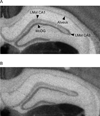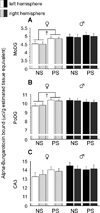The effects of prenatal stress on alpha4 beta2 and alpha7 hippocampal nicotinic acetylcholine receptor levels in adult offspring
- PMID: 23749479
- PMCID: PMC4438756
- DOI: 10.1002/dneu.22097
The effects of prenatal stress on alpha4 beta2 and alpha7 hippocampal nicotinic acetylcholine receptor levels in adult offspring
Abstract
Prenatal stress in humans is associated with psychiatric problems in offspring such as anxiety, depression, and schizophrenia. These same illnesses are also associated with neuronal nicotinic acetylcholine receptor (nAChR) dysfunction. Despite the known associations between prenatal stress exposure and offspring mental illness, and between mental illness and nAChR dysfunction, it is not known whether prenatal stress exposure impacts neuronal nAChRs. Thus, we tested the hypothesis that maternal stress alters the development of hippocampal alpha4 beta2 (α4β2∗) and alpha7 (α7∗) nicotinic receptor levels in adult offspring. Female Sprague-Dawley rats experienced unpredictable variable stressors two to three times daily during the last week of gestation. At weaning (21 days) the offspring of prenatally stressed (PS) and nonstressed (NS) dams were assigned to same-sex PS or NS groups. In young adulthood (56 days), the brains of offspring were collected and adjacent sections processed for quantitative autoradiography using [125I]-epibatidine (α4β2* nicotinic receptor-selective) and [125I]-α-bungarotoxin (α-BTX; α7* nicotinic receptor-selective) ligands. We found that PS significantly increased hippocampal α4β2* nAChRs of males and females in all subfields analyzed. In contrast, only females showed a trend toward PS-induced increases in α7* nAChRs in the dentate gyrus. Interestingly, NS females displayed a significant left-biased lateralization of α7* nAChRs in the laconosum moleculare of area CA1, whereas PS females did not, suggesting that PS interfered with normal lateralization patterns of α7* nAChRs during development. Taken together, our results suggest that PS impacts the development of hippocampal nAChRs, which may be an important link between PS exposure and risk for neuropsychiatric illness.
Keywords: acetylcholine; alpha-bungarotoxin; alpha4 beta2; alpha7; anxiety; asymmetry; depression; epibatidine; gestation; hippocampus; lateralization; maternal; memory; nicotinic; prenatal stress; psychopathology; stress.
Copyright © 2013 Wiley Periodicals, Inc.
Figures





References
-
- Adams CE, Broide RS, Chen Y, Winzer-Serhan UH, Henderson TA, Leslie FM, Freedman R. Development of the [alpha]7 nicotinic cholinergic receptor in rat hippocampal formation. Developmental Brain Research. 2002;139:175–187. - PubMed
-
- Buehlmann E, Berger GE, Aston J, Gschwandtner U, Pflueger MO, Borgwardt SJ, Radue E-W, Riecher-Roessler A. Hippocampus abnormalities in at risk mental states for psychosis? A cross-sectional high resolution region of interest magnetic resonance imaging study. Journal of Psychiatric Research. 2010;44:447–453. - PubMed
-
- Caldarone BJ, Harrist A, Cleary MA, Beech RD, King SL, Picciotto MR. High-affinity nicotinic acetylcholine receptors are required for antidepressant effects of amitriptyline on behavior and hippocampal cell proliferation. Biological Psychiatry. 2004;56:657–664. - PubMed
-
- Charil A, Laplante DP, Vaillancourt C, King S. Prenatal stress and brain development. Brain Research Reviews. 2010;65:56–79. - PubMed
Publication types
MeSH terms
Substances
Grants and funding
LinkOut - more resources
Full Text Sources
Other Literature Sources
Medical
Miscellaneous

